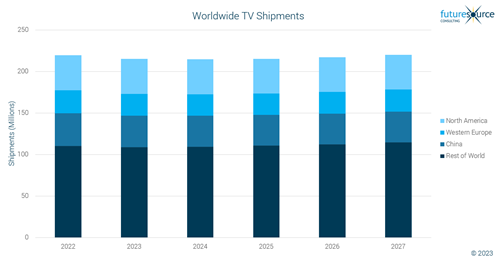TV shipments to fall by 2% in 2023 as the market normalises post-pandemic
Global demand for televisions is set to remain weak in 2023, with total TV shipments for 2023 forecast to contract by 2%. Although some pockets of optimism remain, and the market is expected to stabilise in the long term, inflation continues to rear its head and dull the global economic outlook, leaving consumers unmotivated to upgrade their televisions. That’s according to Futuresource Consulting’s latest report into the global TV market outlook.
A difficult period for TV manufacturers
“The current sociopolitical and economic landscape is continuing to exert pressure on TV manufacturers,” says James Manning Smith, Senior Analyst, Futuresource Consulting. “While the picture varies across regions, Europe is bearing the brunt of these difficulties, with demand in the region falling by 5.7% in 2023.”
North America is benefiting from a more optimistic economic outlook, though demand will only be cushioned to a flat rate year-on-year, as consumers remain cautious in the economic climate.
“In a bid to add meat to already tight margins, revenue-driving features are featuring more heavily in TVs, as the battle for TV OS domination surges. Samsung’s FAST (free advertising supported television) is a prime example, and we’re expecting more TV manufacturers to develop recurring revenue generation features,” says Manning Smith.
“Recovery in the post-pandemic landscape has been far from linear. The Russian-Ukraine war is continuing to elevate energy prices, which is stretching recovery into 2024. It’s not an easy period for manufacturers, but the good news is that market normalisation is on the horizon.”

China sees volumes decline
China is also set to see volumes decline in 2023, with shipments forecast to fall by 4.3%. As the zero-Covid policy is lifted, consumers will likely direct their spending outside of the home. Coupled with the turbulent global economy, this is causing demand for TVs in the region to fall.
“Despite the domestic circumstances, Chinese TV manufacturers are continuing to challenge the status quo in the brand landscape,” says Manning Smith. “Brands like Hisense, TCL, Changhong, and Skyworth have been expanding their international consumer base in 2022, offering mid to high-end TVs at lower prices than South Korean counterparts. This will continue across the remainder of 2023.”
OLED technology generates new opportunities
OLED TVs are gaining traction in the market, as more consumers opt to invest in modest-sized OLED televisions as opposed to larger LCD models. This is driving the growth of 40-44” OLED TVs.
“Manufacturers have typically reserved OLED screen technology for larger screen sizes, but with the launch of smaller OLED TVs, manufacturers have made more palatably priced OLED TVs available. This is driving OLED panel production to ramp up in scale, but overall, the technology remains a small premium segment of the market,” says Manning Smith.
Growth of the OLED technology will continue through 2027, according to the firm’s report. OLED accounted for 3.1% of TV shipments in 2022 and Futuresource expects this figure to climb to 9.3% by 2027.
To enquire about Futuresource’s report on the global TV market, please get in touch with Leon at leon.morris@futuresource-hq.com.